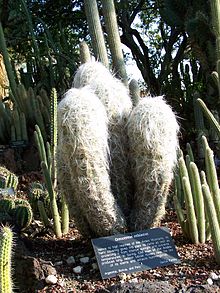| Oreocereus celsianus | |
|---|---|

| |
| Conservation status | |
 Least Concern (IUCN 2.3) | |
| Scientific classification | |
| Kingdom: | Plantae |
| Clade: | Tracheophytes |
| Clade: | Angiosperms |
| Clade: | Eudicots |
| Order: | Caryophyllales |
| Family: | Cactaceae |
| Subfamily: | Cactoideae |
| Genus: | Oreocereus |
| Species: | O. celsianus |
| Binomial name | |
| Oreocereus celsianus (Salm-Dyck) A.Berger ex Riccob. | |
| Synonyms | |
List
| |
Oreocereus celsianus, or the old man of the mountain is a member of the family Cactaceae native to the high lands of the Andes in South America, and is named for its fluffy white hair, which may protect it from intense sunlight and extreme temperatures.
Description
Oreocereus celsianus grows with upright, columnar shoots that branch out from the base and reaches heights of up to around 3 metres (10 ft) tall with a diameter of 8 to 12 cm (3.1 to 4.7 in). O. celsianus is covered in a downy white hair and spines, with greatest density at the tips of stems receding to near-bare at the base. There are 10 to 25 rounded and tuberous ribs, typically with eleven ribs, has many long, brown spines. The large areoles on it are white, densely covered with spines and covered with hairs up to 5 cm (2.0 in) long. The strong, one to four central spines are up to 8 cm (3.1 in) long, the seven to nine radial spines are up to 2 cm (0.79 in) long. The plants blooms in spring with long, tubular, bright, slightly purplish-pink flowers, appear near the tips of the shoots. They are 7 to 9 cm (2.8 to 3.5 in) long and have a diameter of up to 3 cm (1.2 in). The fruits are spherical.
Taxonomy
The first description as Pilocereus celsianus was made in 1850 by Charles Lemaire in Joseph zu Salm-Reifferscheidt-Dyck's Cacteae in horto Dyckensi cultae anno 1849. The specific epithet celsianus honors the French gardener Jean-François Cels (1810-1888), who, together with his brother Auguste Cels (1809-1898), was known for growing cacti and orchids. Vincenzo Riccobono placed them in the genus Oreocereus in 1909.
Distribution
Oreocereus celsianus occurs in the Bolivian departments of Chuquisaca, Potosí and Tarija, Peru, and the Argentine province of Jujuy in the puna vegetation at altitudes of 2900 to 3600 meters.
Ecology
Pollinated by hummingbirds in spring.
Cultivation
Thrives at 10–12 °C (50–54 °F), with a frost-tolerance of down to −12 °C (10 °F) and requiring protection from hot sunlight. Prefers full sun and light watering. Propagates from seed.

References
- "The IUCN Red List of Threatened Species". IUCN Red List of Threatened Species. 2010-09-23. Retrieved 2023-08-25.
- "The Plant List: A Working List of All Plant Species".
- Eggli, Urs; Newton, Leonard E. (2010-11-30). Etymological Dictionary of Succulent Plant Names. Springer. p. 43. ISBN 978-3-642-05597-3.
- "Cacteæ in horto dyckensi cultæ anno 1849, secundum tribus et genera digestæ additis adnotationibus botanicis characteribusque specierum in enumeratione ..." HathiTrust. 2022-10-19. Retrieved 2023-08-26.
- Palermo, Orto botanico di (1908). "Bollettino del R. Orto Botanico di Palermo". Libreria internazionale, Alberto Reber. Retrieved 2023-08-26.
- Huntington Botanical Gardens
- Desert Gardening Archived 2016-05-15 at the Wayback Machine
External links
 Media related to Oreocereus celsianus at Wikimedia Commons
Media related to Oreocereus celsianus at Wikimedia Commons Data related to Oreocereus celsianus at Wikispecies
Data related to Oreocereus celsianus at Wikispecies
| Taxon identifiers | |
|---|---|
| Oreocereus celsianus |
|
| Pilocereus celsianus | |



